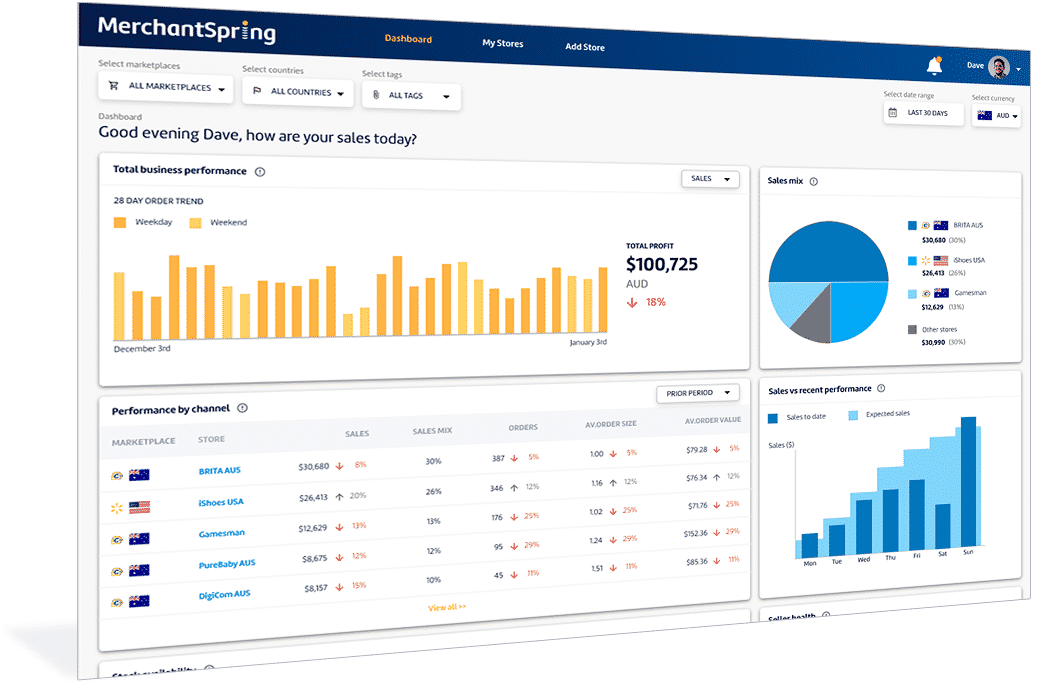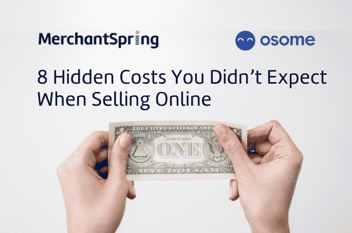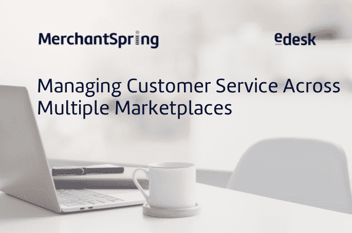Top 9 Online E-Commerce Marketplaces for Online Retailers
If the year 2020 has taught us something, it is that digital is the way to go. The COVID-19 pandemic has put e-commerce at the forefront of retail. Consumers have been purchasing more products online and that they will continue to spend a higher proportion of their income on retail products online than in-store, even after the pandemic subsides. In particular, for the convenience of shopping in one location, shoppers are turning to marketplaces to browse, compare prices, and purchase items.
As sellers, the success of your businesses relies heavily on the online marketplaces where you choose to list your products. Your marketplace decides your target demographic, scope, a significant portion of your operating costs, and the policies and regulations you must follow as a vendor — all of which can have a significant effect on your credibility and bottom line.
In this article, we have assembled a comprehensive list of all online marketplaces from around the world. They're all different, so use this guide to find out which marketplace can help you stand out and earn your share of the substantial revenue available, based on the features you need, your budget, and your overall e-commerce goals.
- Amazon
Amazon is the world's most well-known online marketplace with around 5 million sellers worldwide and a quarter of a billion online buyers locally in America. It's a fiercely competitive market, however small, medium, and large sellers can all participate – as it provides exposure to millions of customers and is equipped to handle the flow of traffic when it comes.
Amazon is a goldmine for brands and retailers because these customers spend an average of $1,400 per year on the site. Having your goods available to Prime members is critical, whether you want to fulfil orders yourself or depend on FBA.
The Amazon marketplace's stringent product listing requirements are one of its most appealing (and infamous) features. Since Amazon standardizes product listing content, the shopping experience is almost seamless between a 3rd party sellers’ product or an Amazon product. In some ways, this is advantageous because the goods gain the same degree of credibility as Amazon products.
The cost to sell on Amazon depends on your selling plan, product category, fulfillment strategy, and other variables. You have to find the combo that works best for you and your goals. On Amazon, the Individual Account costs you $0.99 per item sold, and the Professional Sellers Account is $39.99 per month. Understanding Amazon’s selling fee structure is important as it will help you manage a marketplace strategy effectively.
- Walmart
With almost 130 million people perusing its product catalogue, Walmart is a formidable rival to Amazon. Almost everything can be found on Walmart Marketplace. Walmart’s e-commerce sales grew by 43% in Q3, 2018 which is the sign of all things positive happening for Walmart. Currently, Walmart allows third-party sellers in 35+ product categories to offer their products on its Marketplace.
There are several advantages to selling on Walmart's website: You'll have access to over 440 million customers who visit Walmart directly, as well as affiliate websites like Jet.com. There are no monthly, annual, or initial setup fees, which is even better. Only commission fees are used by Walmart.
Walmart, on the other hand, is an invite-only marketplace, so you'll have to wait a little longer to launch. The first step is to fill out Walmart's application if you believe your products would be a good addition to Walmart's current online product range. You must have quick fulfilment practices in place, a wide variety of high-quality products, and fair pricing to be accepted. Walmart does not accept sellers that only sell via Amazon FBA, but they do accept drop shippers.
- eBay
eBay, the original online auction website, has been around since 1995 and became popular in the early 2000s. The influence of eBay sales is undeniable. As one of the longest-standing e-commerce marketplaces, eBay has over 1.3 billion listings and 182 million users worldwide, according to 2021 eBay Statistics.
There is almost nothing that you can’t sell on eBay. The eBay Seller Hub is built to help you run your company as smoothly as possible, even if you're just getting started and don't yet have a website. As an online platform, eBay allows sellers to add banner images, featured items, larger product pictures, product categorization, a customer newsletter, and more to their eBay storefront. Plus, you can also look at product patterns and see which of your products are the most popular, which promotions are the most popular, how long it takes you to select and ship products, and much more.
To sell on eBay, users must pay an insertion fee when making a listing and a final value fee when the item is sold to sell items on eBay. The retailers and advertisers would not be charged a monthly or annual fee.
- Etsy
It is exclusive and niche. Aimed for creative professionals, Etsy is a popular marketplace for all kinds of handmade, novelty, and antique products. It now has over 54 million users, over 198 million sellers in 83 countries across the world, and over 35 million buyers, making it the de-facto platform for sellers.
Unlike other marketplaces, Etsy sellers sell products independent of the Etsy brand. Etsy vendors, unlike other marketplaces, offer goods that are not associated with the Etsy name. In other words, consumers are aware that they are purchasing your products rather than those that appear to be offered by the marketplace.
This feature is great to preserve your brand identity which is particularly important if you don't have a separate website. If you're new to e-commerce and want to spread the word about your goods and company, Etsy offers you the freedom to develop and nurture a loyal consumer base as you expand.
In addition, Etsy provides the first 40 listings for free. It charges $.20 per item to be listed for four months with 5 percent of the transaction fee.
- Jet
Although Walmart acquired jet.com, the marketplace is completely independent of the parent company.
Jet is the perfect online platform for sellers who appeal to budget-conscious millennial city dwellers. Now, there are approximately 400,000 monthly active users and 2,400 sellers on the web. Although this market is still limited, Jet provides more exposure to buyers and it has a repeat buyer rate of 23%, which is higher than Amazon and eBay.
Jet's winning approach combines bulk-buying discounts and smart cart delivery solutions to entice price-conscious shoppers in the United States to stock up on everything from toilet paper and toothpaste to Lego and laptops. Customers are rewarded for purchasing in bulk on the web, making it a perfect place for sellers who can handle larger amounts, known as Jet Retail Partners. Jet's ground-breaking algorithm targets items with discounts available depending on the seller's position and shipping costs. The more things you purchase, the greater the savings.
- Rakuten
Rakuten is the biggest Japanese e-commerce and online retailing company founded in 1997 and is also the fourth largest e-commerce site in the world. It serves as a great platform for medium to large businesses looking to enter the Japanese market.
To be successful, you have to do it the Rakuten way. Rakuten has a strong points scheme that is linked to customers’ credit cards and is used in hundreds of stores across Japan. Customers can earn points for purchases made on the Rakuten market as well as purchases made in participating shops.
Having a service like this built into an online marketplace saves you time and simplifies the redemption process by removing the need to create and manage your own. This is important because repeat customers account for 40% of e-commerce sales. This feature lets you save money on new customer acquisition in the long run. Instead, you can put your extra cash into product growth.
- Shopify
Shopify is an e-commerce platform used by over one million businesses - that allows you to create your online shop. From store design to shipping, it has the resources you need to start and run your company. Whilst not a marketplace, Shopify caters to all sellers of consumer goods, which makes it one of the best platforms to use for selling via your own website.
The pricing plan of Shopify is designed in a very start-up-friendly manner. If you use Shopify to build your marketplace, you can save money because your marketing budget will be reduced. Shopify offers marketing tools that allow you to sell your goods online without breaking the bank.
resources for a small monthly fee of $29 per month, you get your own website, forum, SSL certificates, abandoned shopping cart recovery, and several other beginner-friendly marketing. You can even sell items on your website as well as on different marketplaces such as Amazon and eBay, and create customized shopping experiences that result in more sales.
- Wish
Wish.com, with its #2 rating app, younger demographic, and 10 million daily users, is a rapidly growing online marketplace that is gaining a lot of seller interest. As the sixth largest e-commerce company in the world, it has more than 300 million users.
The platform’s interface is a little different from other marketplaces. They've embraced the gamification idea to have a truly authentic shopping experience, complete with plenty of gaming elements on the platform. The leitmotiv "Shopping Made Fun" could not be more apt.
The best thing about Wish Marketplace is that there are no pre-defined conditions for sellers to meet before they can sell on it. You will receive Wish's Seller Panel in 5 minutes after submitting your application, and all of your items will be submitted for sale within 2 days. It is definitely the easiest and most mess-free marketplace to sell your products. Just go ahead and start your business carrier on Wish without thinking twice!
- Cratejoy
Cratejoy is an all-in-one subscription e-commerce platform that provides customers with a website where they can browse hundreds of different subscription boxes from independent sellers.
Cratejoy has several unique features, including subscription-specific logistics, fulfilment management, and shipping, tax-smart checkout, and resource guides such as their blog and webinars. In comparison to other marketplaces, these features cater to the unique needs of subscription box owners, making your experience here easy and effective.
Their ease-of-use features for sellers mean that they’ll do schedules, billing, and a whole lot more for you. But of course, they all came with a fee of $39 a month, plus transaction fees that vary depending on whether you sell through your website or the CrateJoy network.
Final Thoughts
There is an online marketplace platform for anything, no matter what you're selling or how you want to sell it. Each platform has its own set of features that cater to various seller sizes and niches. To find a match, you need to reflect on your goals and needs. This varies by company and is determined by factors such as marketplace fees, criteria, and top categories. This may all seem daunting at the outset, but you can use MerchantSpring Marketplace Manager to unlock the full power of all your e-commerce marketplace sales data in every country that you sell.
To know more about how we can help, reach us and check out what MerchantSpring can offer.










Add a Comment